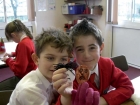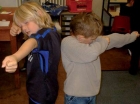Cross Curricular
There is history in everything and engaging children through cross curricular approaches is an exciting way of developing an immersive experience and transferable knowledge and skills. This section provides ideas and suggestions on how to develop cross curricular approaches to your lesson planning.
Sort by:
Date (Newest first) | Title A-Z
Show:
All |
Articles |
Podcasts |
Multipage Articles
-

The Leeds Community History Project
ArticleClick to view -

History and geography are fundamental in the primary curriculum
ArticleClick to view -

Art and History: Justifying the Links
ArticleClick to view -

What are the reasons for linking art and history?
ArticleClick to view -

The Dramas of History
ArticleClick to view -

Researching History - Time travellers and Role Players
ArticleClick to view -

Think Bubble 48: Lighting fires
ArticleClick to view -

Getting Started with Drama: The Roses of Eyam 1665
ArticleClick to view -

History through Drama, A Teachers' Guide - Revisited
ArticleClick to view -

Drama and history: a theory for learning
ArticleClick to view -

Drama - Choosing an approach
ArticleClick to view -

Working through drama
ArticleClick to view -

Means and Ends: History, Drama and Education for Life
ArticleClick to view -

Music in the History Curriculum
ArticleClick to view -

A Load of Rubbish: Using Victorian throwaways in the classroom
ArticleClick to view -

Identity Crisis: History through Science, strange bedfellows or obvious partners?
ArticleClick to view -

Archaeology - An approach to teaching history at Key Stage 2. Curriculum history
ArticleClick to view -

The strange power of hats: using artefacts and role play in cross-phase, cross-curricular and community partnership work
ArticleClick to view -

History and English in the primary school: exploiting the links
ArticleClick to view

